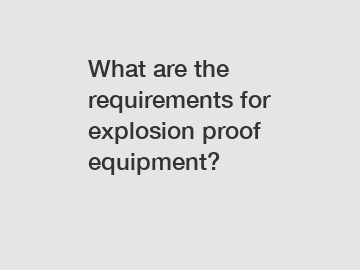What are the requirements for explosion proof equipment?
What are the requirements for explosion-proof equipment?
Explosion-proof equipment is crucial for ensuring safety in environments where there is a risk of explosive or flammable gases, vapors, or dusts. Such equipment is designed to contain and prevent the ignition of hazardous substances, protecting both personnel and property from potential explosions. To guarantee the effectiveness of explosion-proof equipment, there are specific requirements that must be met. In this article, we will delve into these requirements and explore the importance of compliance in creating a safe work environment.
1. Hazardous Area Classification:

The first step in determining the requirements for explosion-proof equipment is to carry out a thorough assessment of the working environment. This involves conducting a hazardous area classification, which divides the area into different zones based on the likelihood and duration of explosive atmospheres. The classification will help determine the appropriate level of protection required for equipment and installations.
2. International Standards:
Compliance with international standards is essential to ensure the reliability and performance of explosion-proof equipment. The most widely recognized international standards for explosion protection are developed by organizations such as the International Electrotechnical Commission (IEC) and the National Fire Protection Association (NFPA). These standards provide guidance on product testing, certification, and manufacturing requirements, ensuring consistency and reliability across different industries and regions.
3. Equipment Marking and Certification:
Explosion-proof equipment must undergo stringent testing procedures and be appropriately certified. The equipment should bear clear markings indicating its compliance with the relevant standards and the ignition protection methods employed. In many cases, these markings are accompanied by a unique certification number, providing traceability and ensuring that the equipment meets the necessary requirements for hazardous environments.
4. Ignition Protection Techniques:
Various ignition protection techniques are used to prevent explosions in hazardous environments. These techniques include explosion-proof enclosures, intrinsically safe circuits, pressurization, and purging systems, among others. Explosion-proof enclosures, for instance, are designed to withstand internal explosions and prevent the ignition of surrounding flammable substances. On the other hand, intrinsically safe circuits limit electrical energy to a level that cannot cause ignition in hazardous atmospheres.
5. Material Selection:
Careful consideration must be given to the materials used in the construction of explosion-proof equipment. Non-sparking materials, such as copper-free aluminum or brass, are commonly employed to minimize the risk of sparks or hot surfaces. Additionally, seals and gaskets used in the equipment must be made of materials compatible with the potentially hazardous substances present in the surrounding environment to maintain their integrity and prevent leaks.
6. Regular Inspection and Maintenance:
To ensure the ongoing effectiveness of explosion-proof equipment, regular inspection and maintenance programs are essential. Inspections should be conducted to identify any damage, deterioration, or unauthorized modifications that may compromise the equipment's ability to contain explosions. Maintenance activities should be carried out in accordance with the manufacturer's recommendations and include testing, cleaning, and verification of the integrity of seals and gaskets.
In conclusion, the requirements for explosion-proof equipment are multi-faceted and require careful consideration. From hazardous area classification to compliance with international standards, each aspect plays a crucial role in ensuring the safety of personnel working in potentially explosive environments. By adhering to these requirements, organizations can minimize the risk of explosions and create a secure work environment for their employees. Remember, when it comes to explosion-proof equipment, meticulous attention to detail is vital.
If you want to learn more, please visit our website ex lighting, Explosion-proof Handle supplier, mamx.


